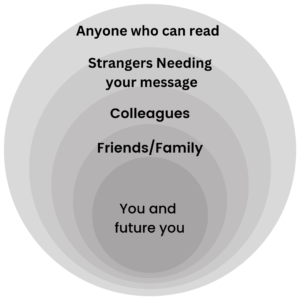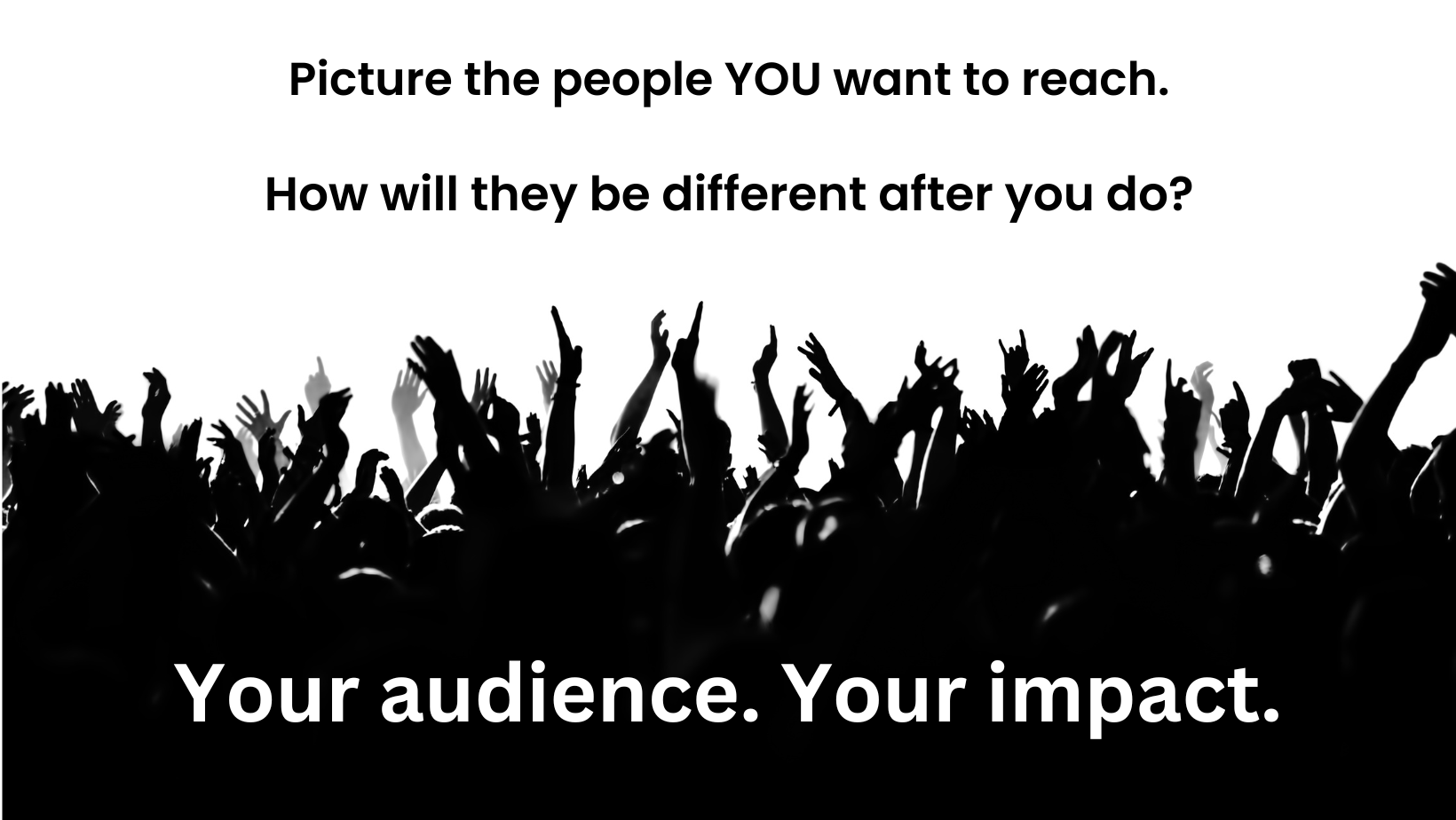Where do ideas for writing come from? Try picturing your audience and thinking clearly about how you want to change them.
My friend, Sherri Fisher, once suggested that I could mine my own book, Sit Write Share, for more ideas. She challenged me to open up the book to any page, select a step from the closest Steps section, and see what else I could say about it. What a fun challenge! I opened Sit Write Share at random to page 59. This step appears in Write Experiment 1: Decide What Goes In:
“Write a sketch of the audience you want to reach and the way you want to change them.”
This very useful step has come up in my own writing practice and in my writing coaching multiple times recently, particularly with people starting to get serious about writing books. It’s one way to focus attention and manage the turbulent emotions that surround writing. This kind of thinking can also produce some good words for the introduction.
Start By Asking Who
 One way to think about the who is to draw embedded circles on a piece of paper.
One way to think about the who is to draw embedded circles on a piece of paper.
People Who Know You
In the innermost circle put yourself, in particular your future self. If you don’t count yourself among the people who want to read your book and will be changed by your message, then perhaps this is not the book for you to write right now.
The next circle out might be family and friends, particularly if you are writing a memoir. When you think about family, don’t forget the descendants that you will never meet yourself. My family still shares the Civil War era story that someone wrote down about my great great grandmother:
“While Gus served the union, Sarah endured persecution at home for being a northern sympathizer and eventually was forced to flee to a refugee camp in Springfield Missouri. This 100-mile journey must have taken four or five days with five children ranging from five to fourteen. Food was scarce and Sarah made the children drink a lot of water before sharing a biscuit. At times she used the boys’ suspenders to lower a cow’s horn into a well to draw water. She let the youngest children believe the biscuits came from the well.”
The next circle might be colleagues that you know by name. With these people, you can think very concretely about what you want to tell them.
That might be as far as you want to go. Perhaps you are only writing for people who know you or have reason to know of you. But if you want to touch a wider audience, keep drawing circles.
People Who Don’t Know You
The next circle will probably include people that you don’t know. What draws them together in your mind? Do they have a particular need that you plan to address? Do they belong to a particular age group, religious group, and/or nationality? Do they have a certain education level? Do they share a particular interest or hobby? Have they had a particular experience or suffered a particular trauma?
The next circle out might be another group like the former, but one which you are slightly less determined to influence. For example, if you were writing a book for dog owners, you might find that there are parts of your message that would be useful to cat owners or even gecko owners. For another example, Sherri Fisher originally targeted her book, The Effort Myth, to people facing learning obstacles directly. That meant mostly students and their parents. Her writing workshop group convinced her that her message could be valuable for all learners and their parents, whether or not they are facing learning obstacles right now. That decision had a big impact on the shape of the book she published.
The next circle might be people who support the people in the circles you’ve already described. For instance, the next circle out for Sherri might be people supporting parents and students, such as teachers, counselors, and any others that might say, “You should read The Effort Myth.”
You may be able to think of more levels of granularity, or your next level might be anybody in the world that can read, if you believe your message is universally helpful. It’s OK to have a very wide outer circle, but it’s probably not where you’ll put most of your attention when you are making writing and marketing decisions for your book.
Next Ask How You Want to Change Them
Now you know the people, think about the ways you want your book to change them.
Perhaps you want them to learn new skills that you are qualified to teach. For Sit Write Share, my goals was to help people find their own voices, get writing done, and share it as far as they want to share it. That’s a general summary of all the people that might pick up my book. I might refine this by having more granular goals for different circles as shown below.
Family and Friends
When I think of my family and friends, I want to motivate them to capture their experiences in ways that enhance our lives together. My sister lived through a major health crisis. I’d love to see her write about how her experiences changed her. One of my brothers lived most of his adult life either in communes or on the edge of communes. Wouldn’t it be interesting to read what he learned from living on kibbutzim in Israel and communes in Missouri, Virginia, and New Zealand? I’m also interested in why doesn’t he live in a commune any more, even though he maintains close connections with more than one.
I also want them to capture stories for future members of the family. I recently interviewed members of another family about their memories of their recently deceased mother. They were amazed by what came to mind, but they also wished they had done it sooner, back when they could have asked her questions.
When my daughter was tiny, she asked her father to tell her a secret. He responded by telling her stories about his family going back to his great grandfather whose first name was Romance. That became part of her bedtime routine. Fortunately he had the good sense to write them down, so they won’t disappear when he can no longer tell them.
Colleagues and Friends
These are likely to be the people who have told you how valuable your messages have been. Your goal may be to capture the things you’ve told them in person in a form that doesn’t require you to be present. This comes up often in my writers’ workshops. For example, when Karen Warner was writing her book, The Sudden Caregiver, people called her when they needed advice about how to handle a sudden health crisis. I myself have sought her advice for 3 different friends. Many people told her she needed to finish it and get it published so others could benefit.
Your goal might also be to create a resource that people can draw on when you aren’t available in person.
Strangers
Now we’re getting to the people you don’t know. Could you express your goals for the next rings of the circle in terms of how you want them to be different after they read your book? Reading a book always changes the reader. What kind of change would you like to create?
I imagine the change Sherri wants is for parents and teachers to face learning obstacles more compassionately and effectively. She wants to damp down the inevitable emotional rushes that occur when difficulties arise. Her ultimate goal is to help her readers help the children in their orbits become competent and confident lifelong learners.
I imagine the change Karen wants is for people who suddenly need to take care of someone they love can grow into the new demands placed on them. She explains that caregiving comes with both hardship and benefits, including growth. I imagine her hard-won experience could help tip the scales toward growth.
For my book, I want people to find their own unique writing practices without having to start from scratch. My experiments are ingredients that they can put together in ways that suit them.
What Next?
Keep the picture of embedded circles, who you want to affect and how you want to affect them, close by while you write. Remembering your audience affects what you include and leave out, the complexity of your arguments, and the stories you choose. In fact, remembering your audience can affect nearly every aspect of imagining, drafting, and editing the message that you take to the world.

